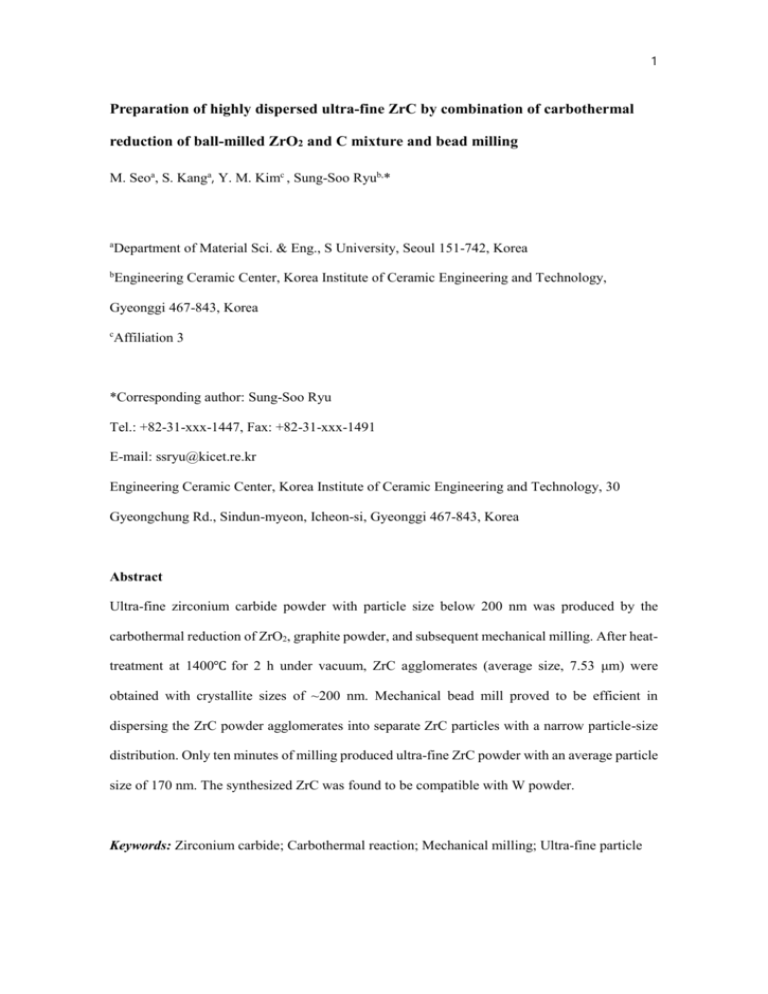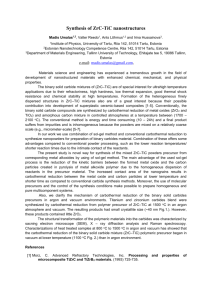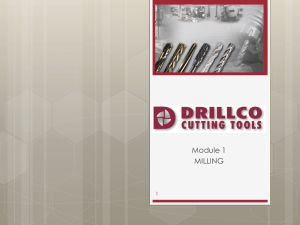IJRMHM template
advertisement

1 Preparation of highly dispersed ultra-fine ZrC by combination of carbothermal reduction of ball-milled ZrO2 and C mixture and bead milling M. Seoa, S. Kanga, Y. M. Kimc , Sung-Soo Ryub,* a Department of Material Sci. & Eng., S University, Seoul 151-742, Korea b Engineering Ceramic Center, Korea Institute of Ceramic Engineering and Technology, Gyeonggi 467-843, Korea c Affiliation 3 *Corresponding author: Sung-Soo Ryu Tel.: +82-31-xxx-1447, Fax: +82-31-xxx-1491 E-mail: ssryu@kicet.re.kr Engineering Ceramic Center, Korea Institute of Ceramic Engineering and Technology, 30 Gyeongchung Rd., Sindun-myeon, Icheon-si, Gyeonggi 467-843, Korea Abstract Ultra-fine zirconium carbide powder with particle size below 200 nm was produced by the carbothermal reduction of ZrO2, graphite powder, and subsequent mechanical milling. After heattreatment at 1400℃ for 2 h under vacuum, ZrC agglomerates (average size, 7.53 μm) were obtained with crystallite sizes of ~200 nm. Mechanical bead mill proved to be efficient in dispersing the ZrC powder agglomerates into separate ZrC particles with a narrow particle-size distribution. Only ten minutes of milling produced ultra-fine ZrC powder with an average particle size of 170 nm. The synthesized ZrC was found to be compatible with W powder. Keywords: Zirconium carbide; Carbothermal reaction; Mechanical milling; Ultra-fine particle 2 1. Introduction Zirconium carbide (ZrC) is a promising material for ultrahigh-temperature applications due to its high melting point (~3550℃), solid-state phase stability, and good thermo-mechanical and thermo-chemical properties [1–4]. ZrC also has high hardness, wear resistance, and high electrical conductivity, making it widely used for cutting tools, wear-resistant components, thermophotovoltaic radiators. [1,2,5]. It has also been used for field emission arrays and as a diffusion barrier coating on UO2 particles in the nuclear industry [6]. Various methods have been reported for the production of ZrC powders, including carbothermal reduction of ZrO2 at elevated temperatures [7,8], solution-based processes [9,10], mechanical alloying [11], and self-propagating high-temperature synthesis [12,13]. Of these methods, the carbothermal reduction of ZrO2 is a promising approach because of its low production cost and simplicity in processing and equipment, although it requires high temperatures and many production steps. The synthesis of ultra-fine or nano-sized ZrC powders has received much attention because powder refinement results in increased driving force in the sintering process, thereby enhancing the microstructure and mechanical properties of the sintered body [10]. Although ultra-fine or nano-sized ZrC powder has been synthesized by several methods [9,10,12,14], few studies have reported the preparation of ultra-fine ZrC powder by carbothermal reduction. Mechanical milling processes are an alternative to chemical and surface modifications in producing stable ultra-fine and nano-particle dispersions [15]. Various mechanical processing methods have been developed to disperse agglomerated particles in liquids, including agitator discs, colloid mills, high-pressure homogenizers, ball mills, sand mills, and bead mills [16,17]. Bead mills are known to be a useful tool in grinding and dispersing agglomerates of ultra-fine or nano-sized particles. Several studies have reported that agglomerated ceramic powders are well dispersed into nano-sized particles by bead milling [18, 19]. According to Inkyo [15], especially, in the vertical type of bead mills, the dispersion of particles occurs during operation as the beads are agitated by the rotor pins (or disc) inside the mill chamber while the material slurry is fed into 3 the mill chamber from bottom. The slurry is dispersed by the impulse from the beads inside mill. Finally, the milled slurry will exit the mill chamber at the top after passing through the seperator to remove the beads. As a result, bead mills impose forces perpendicular to the radial forces due to the strong flow of slurry along the longitudinal axis of movement on to the bead-on-bead action within the mill which is absent in the ball mill such as the planetary mill. Thus, strongly agglomerated particles are easily sheared between small, hard-materials beads such as ZrO2 in a confined volume during the bead milling process. And also, since ball mill relies partially on impact breakage, a grinding ball with a certain size (more than 1 mm) in a diameter is needed to generate enough kinetic energy during rotational movement. While, since beads mill can use finer beads down to size less than 0.05 mm, it is more likely to make contact with the particles compared to the ball mill, resulted in the improved dispersing efficiency. On the other hand, ZrC improves the high temperature strength of tungsten acting as a dispersive strengthening phase due to the good compatibility [20- 22]. In the present study, we investigated the preparation of ultra-fine ZrC powder by carbothermal reduction from milled mixture of ZrO2 and graphite powder, along with additional bead milling. We also examine the effectiveness of bead milling in separation of agglomerated ZrC particles and its compatibility with W. 2. Experimental procedure ZrO2 powder (99.9 %, Aldrich, 5 μm) and graphite powder (Seunglim carbon metal, < 1.65 μm) as a carbon source were used as starting materials. The amount of carbon was calculated based on the fact that most of the oxygen in the system is reduced by carbon in the form of CO. According to the Ellingham diagram, CO phase is thermodynamically stable above 1200K temperature [23, 24]. The oxide powder mixtures were subjected to high-energy ball milling using a planetary mill (Fritsch Pulverisette 7, Fritsch, Germany). Tungsten carbide balls (diameter, 6.0 mm), as milling media, were mixed with the powder mixtures at a ball-to-powder weight ratio (BPR) of 40:1. A tungsten carbide coated bowl was used under anhydrous conditions at 250 RPM 4 for a period of 20 h. No liquid solvent was used during the milling process. ZrC is expected to form by the following reaction: ZrO2+3C → ZrC+ 2CO (1) The milled powders were reduced and carburized under vacuum in the temperature range of 1300–1600 ℃ for 2 h. Subsequent bead milling was employed for as-reduced ZrC powder using a vertical super-fine grinding mill (UAM-015, Kotobuki Eng. & Mfg. Co. Ltd., Kure, Japan) to disperse the agglomerated ZrC particles. Mechanical milling of ZrC powder was performed with a packing rate of ZrO2 beads (diameter, 0.2 mm) as high as 85%, loaded in a container (volume, 0.15 L) with slurry consisting of 50 g of ZrC powder and 500 mL of distilled water. An agitation rate of 4000 rpm was used to obtain strong shearing forces. For comparison, ZrC powder was subjected to horizontal ball milling in plastic bottle with ethyl alcohol, after the reduction/carburization process, for up to 120 min at 150 rpm. The BPR was 10:1 in weight, using WC-Co balls (diameter, 6.0 mm) as milling media. The phases were analyzed by X-ray diffraction analysis (M18XHF-SRA, MAC Science Co., Japan) using Cu-K_ radiation at 50 kV and 100 mA. Before and after milling, the particle size distributions of the ZrC powders were measured using a laser particle size analyzer (LA-950V, Horiba, Japan). Field-emission scanning electron microscopy (FE-SEM; JSM-5600N, JEOL Ltd., Japan) was used to confirm the particle morphology and size. The gas evolution during carbothermal reduction was determined using a mass spectrometer (QMS 403, NETZSCH, Germany) under helium flow. The onset temperature was determined by differentiation of gas evolution graph using “Netsch proteus-thermal analysis (ver. 4.8.1) program. W powder with an average size of 1.8 μm (purity > 99.9 wt%, Taegu Tec, Korea) was used to fabricate W matrix composites. The synthesized ZrC was dispersed as the reinforcement element. For comparison, commercial ZrC powder of an average size of 3.4 μm(>98% wt%, High purity chem.) was also used. And W-ZrC powders were put in a graphite mould and subjected to hot-pressing at 1900 ◦C under 25 MPa for 2 h in the vacuum atmosphere of 10-2 torr. Specimens 5 with dimensions of 3 mm × 4 mm × 30 mm were prepared by cutting the sintered disk for flexural strength measurement by three point bending method with a 20 mm span. Microstructure analysis was examined with FE-SEM. 3. Results and Discussions Figure 1 In figure 1, typical powder X-ray diffraction pattern of milled and heat treated powders formed at 1300oC~1600oC for 2hours. It is clearly seen that the crystalline structure of ZrC after carbothermal reduction. At 1300oC, the ZrC phase was observed with some residual tetragonal ZrO2 (t-ZrO2) and monoclinic ZrO2 (m-ZrO2). Oxide phase was partially remained because of not enough reduction temperature. By contrast, it shows complete ZrC phase above 1400 oC. It is interesting that general heat treatment process was reported to require at least 1800oC for synthesis of carbide. [8] That is, high energy ball milling derived unstable state, it resulting much lower reaction temperature due to the high density of defects and small particle size. According to the research on mechanical ball milling by Cui et al. [25], the activation energy of powder for reaction reduces with the ball milling process. Also, Kwon have examined the effect of high-energy milling on the phase transformation of milled oxide mixture using the Rietveld method. [24] Figure 2 Milling effect can be definitely confirmed with the gas evolution of CO/CO2 during carbothermal reduction of ball-milled ZrO2 and C mixtures in figure 2. The temperature range for the reduction was varied with respect to the milling time. The onset temperature decreased from near 800℃ to 650℃. It is well agreement with the previous Kwon and Kang’s study which showed the linear change of reduction temperature due to the change of lattice micro-strain and particle size during milling. [24] High lattice strain and low particle size during milling process could make the system much unstable. It reduces effectively the reaction temperature of oxide during reaction stage, resulted in final ZrC particles with less agglermates. That is, during the carbothermal reaction, reduction 6 in the internal energy can only be achieved by reducing the total area of grain boundary. Thus, lower reduction temperature leads to finer ZrC powder which shows less agglomeration. Figure 3 Figure 3 shows XRD pattern which can support the relationship between milling effect and reaction temperature. Raw powder shows high crystallinity in Figure 3(a) while diffraction peaks of the ZrO2 phase were broadened with a simultaneous decrease in their intensity after 20 h milling due to the reduction of crystallite size and accumulation of micro-strain (Figure 3(b)). And no new peaks were observed, indicating that no in-situ mechano-chemical reactions took place. Figure 4 Figure 4 shows the FE-SEM morphology of ZrC powder after carbothermal reduction at different heat-treatment temperatures for 2 h under vacuum. The particle size of the powders shows an increase with increasing temperature during the reduction process. Although ZrC powder is irregular in morphology and ultra-fine (~ 200 nm) in size, it shows the occurring as agglomerates with an average agglomerate size of ~7.53 μm at 1400℃, and ~9.50 μm at 1600℃. Figure 5 In order to separate ZrC agglomerates, additional milling process carried out after carbothermal reduction. Figure 5 shows the temporal change in the average particle size of ZrC which is analyzed by laser analysis, as a function of additional milling time. Although a planetary mill carried out for 120 min to separate agglomerates of ZrC, average particle size reached to steady-state value at 60 min, having particle size of ~4μm. It means that general ball milling process has a limitation to disperse ZrC ceramic agglomerates. Figure 6 Therefore, mechanical bead mill was introduced to disperse agglomerates of ZrC and to break the necking among the powder particles. Figure 6 shows the great decrease of the average particle size of ZrC which is synthesized at 1400℃, with a function of milling time of bead mill. Originally as-reduced ZrC was 7.53μm average particle size but finally it decreased to 230 nm 7 after 5 min of milling and reached 170 nm after 10 min which is measured by a laser diffraction particle-size analyzer.. During milling, agglomerated particles were sheared by small ZrO2 beads in a confined volume, resulting in separated, fine particles. The rate of decrease in the size of individual particles becomes smaller with increasing milling time. It means that the degree of necking (or abundance of agglomerates) between the particles in the reduced ZrC powder is not extensive, even after heat-treatment at a high temperature (>1400 ℃). As seen in Figure 5, the average particle size of ZrC decreased from ~8 μm to ~4 μm even for 60min, revealing that general planetary ball milling is less effective than bead milling in terms of fragmentation of ZrC agglomerates. Meanwhile, bead milling process can provide strong shearing effect via a large bead-to-bead contact surface due to the micron size of bead and relatively low impact energy (lattice strain) compared with the general ball milling [19]. Also the difference in the effectiveness of fragmentation between the two techniques is derived not only from the size effect of the media but also from dispersion of ball and powder during milling. In general, ball and powder lump to the side of wall during the ball milling due to the nature of centrifugal force. However, ball and powder can be homogeneously dispersed using the bead milling. Also unlike to conventional milled powder, an intense broadening of the diffraction peaks and a decrease in the X-ray intensities did not occurred after bead milling, meaning that there is no change in primary particle size or microstrain of as-reduced ZrC powder even after mechanical milling. Thus, great fragmentation of ZrC agglomerate was possible without losing its crystallinity. 4. Conclusions To produce ultra-fine zirconium carbide (ZrC) powder, milled powder comprising a mixture of ZrO2 and graphite was subjected to carbothermal reduction followed by bead milling. All of the ZrO2 was transformed to ZrC after heat-treatment at 1400℃ for 2 h under vacuum. High energy ball milling of starting powder mixture led to lowering reaction temperature by 400℃ compared 8 to that for the conventional carbothermal process. Treatment at 1400 C yielded ZrC powder agglomerates of around 7 μm in size, consisting of fine particles of ~200 nm. Dispersing process of this ZrC powder in a bead mill produced ultra-fine particles of 170 nm in average size with a narrow particle-size distribution, as a result of strong shearing forces applied to the agglomerated particles. Flexural strength of W-10wt%ZrC composite using ultra-fine ZrC powder being 740 MPa increased by around 2 times than that of specimen using micrometric ZrC which was 377 MPa. Acknowledgments References 1. Edmond K. Storms, “The Refractory Carbides”. New York and London: Academic Press;1967: 18-27 2. Perry A. J., “The refractories HfC and HfN - A survey I.”, Powder Metall. Int. 1987;19:29-31 3. Upadhya K., Yan J. M., and Hoffman W. P., “ Materials for ultrahigh temperature structural applications”, Bull. Amer. Ceram. Soc. 1997; 76: 51-56 . 4. Opeka M. M., Talmy I. G., Wuchina E. J. and Causey S. J., “Mechanical, thermal, and oxidation properties of refractory hafnium and zirconium compounds”, J. Eur. Ceram. Soc. 1999; 19: 2405-2414 5. Mackie W. A., Zie T. B., Matthews M. R. and Davis P. R., “Hafnium carbide films and filmcoated field emission cathodes”, J. Vac. Sci. Technol. B 1998; 16: 2057 6. Minato K., Tomita T., and Iida S. et al., “Irradiation experiment on ZrC-coated fuel particles for high-temperature gas-cooled reactors”, Nucl. Technol. 2000;130: 272 7. Maitre A., and Lefort P., “Solid state reaction of zirconia with carbon”, Solid State Ion. 1997; 104: 109-122 8. Dong J., Shew W., Liu X. and Kang F. et al., “A new method synthesizing the encapsulated 9 ZrC with graphitic layers”, Mater. Res. Bull. 2010; 36: 933-988 9. Sacks M. D., Wang C. A., Yang Z. H. and Jain A., “Carbothermal reduction synthesis of nanocrystalline zirconium carbide and hafnium carbide powders using solution-derived precursors”, J. Mater. Sci. 2004; 39: 6057-6066 10. Yan Y., Huang Z., Liu X., and Jiang D., “Carbothermal synthesis of ultra-fine zirconium carbide powders using inorganic precursors via sol-gel method”, J. Sol-Gel Sci. Technol. 2007;44: 81-85 11. Mahday A. A., Sherif El-Eskandarany M., Ahmed H. A., and Amer A. A., “Mechanically induced solid state carburization for fabrication of nano-crystalline ZrC refractory material powders”, J. Alloys Compd. 2000; 299: 244-253 12. Li J. and Niihara K., “Preparation of ZrC by self-propagating high-temperature synthesis”, Ceramics International 2010;36: 1681-1686 13. Song M. S., and Huang B., “In situ synthesis of ZrC particles and its formation mechanism by self-propagating reaction from Al-Zr-C elemental powders”, Powder Technol.2009; 191: 3438 14. Tao X., Qiu W., Li H., and Zhao T., “Synthesis of nanosized zirconium carbide from preceramic polymers by the facile one-pot reaction”, Polym. Adv. Technol. 2010;21: 300-304 15. Inkyo M., Tahara T., Iwaki T., Iskandar F., Hogan C.J. and Jr., Okuyama K., “Experimental investigation of nanoparticle dispersion by beads milling with centrifugal bead separation”, J. Colloid Interface Sci. 2006; 304: 535-540 16. Muller F., Peukert W., Polke R., and Stenger F., “Dispersing nanoparticles in liquids”, Int. J. Miner. Process, 2004; 74: 31-41 17. Mckay R. B., “Technological Applications of Dispersion”, Dekker, New York, 1994. 18. Qiu J. Y., Hotta Y., and Mitsuishi K., “Fabrication of Fine AlN Particles by Pulverizing with Very Small ZrO2 Beads”, J. Am. Ceram. Soc. 2005; 88: 1676-1679 19. Lee G. W. and Kim K. K. et al., “Structural, optical and photoelectrochemical studies on the nanodispersed titania”, Curr. Appl. Phys ,2009; 9: 900-906 10 20. Song G. M., Zhou Y., Wang Y. J ., and Lei T. C., “Elevated temperature strength of a 20 vol%. ZrCp/W composite”, J. Mater. Sci. Lett. 1998;17: 1739-1741 21. Song G. M., Wang, Y. J. and Zhou Y., “Elevated temperature ablation resistance and thermophysical properties of tungsten matrix composites reinforced with ZrC particles”, J. Mater. Sci. 2001;36: 4625 – 4631 22. Zhang T., Wang Y., Zhou Y., and Song G.M., “Effect of ZrC particle size on microstructure and room temperature mechanical properties of ZrCp/W composites” Mater. Sci. Eng. A 2010; 527 :4021–4027. 23. Gaskell. Introduction to the Thermodynamics of Materials. 4th. New York and London, ;2003:359 24. Kwon H. J., and Kang S., “Effect of milling on the carbothermal reduction of oxide mixture for (Ti,W)C-Ni”, Materials Transactions, 2008; 49: 1594-1599 25. Cui X. L. and Wang L., “Synthesis of titanium carbide powder from TiO2 and petroleum coke by reactive milling”, Pet. Sci. Technol. 2002; 20: 999-1007 11 Figure captions Figure 1. X-ray diffraction patterns of ZrC powder reduced at different temperatures for 2 h under vacuum. Figure 2. Gas evolutions of CO/CO2 during carbothermal reduction of ZrO2 and C mixture after high energy ball milling for (a) 5 h, (b) 10 h and (c) 20 h in planetary mill. Figure 3. X-ray diffraction patterns of (a) raw ZrO2 and C powders and (b) 20h-milled powder mixture. Figure 4. FE-SEM morphologies of ZrC powder reduced at different heat-treatment temperatures for 2 h under vacuum: (a) 1300℃, (b) 1400℃, (c) 1500℃, and (d) 1600℃. Figure 5. Change in average particle size as a function of milling time for ZrC powder reduced at 1400℃ for 2 h under vacuum. Figure 6. Change in average particle size as a function of milling time for ZrC powder reduced at 1400℃ for 2 h under vacuum which was mechanical-milled in a bead mill. 12 m-ZrO2 t-ZrO2 ZrC o Intensity (a.u.) 1600 C o 1500 C o 1400 C o 1300 C 20 30 40 50 60 2 Theta (deg.) Figure 1 70 80 13 Figure 2 14 Figure 3 15 Figure 4 16 Figure 5 Average particle size (m) 17 10 1 0.1 as-reduced 5 Milling time (min) Figure 6 10







